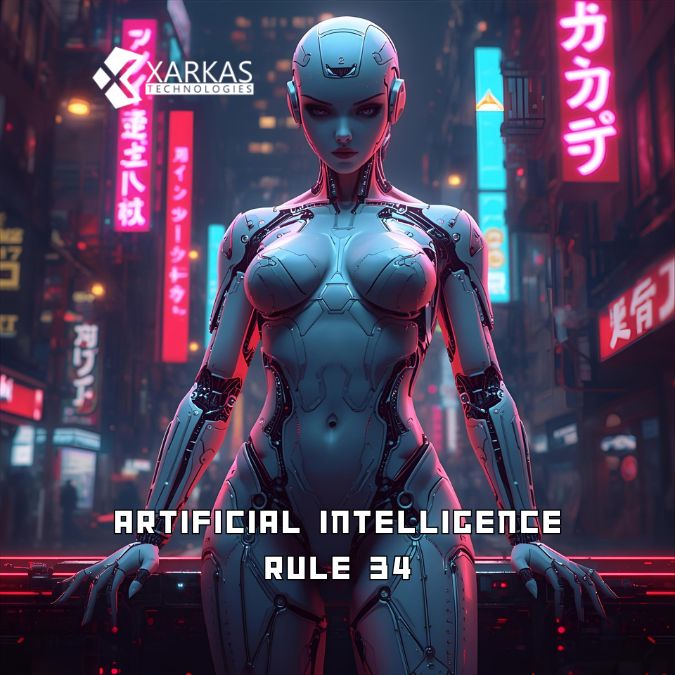
Artificial Intelligence Rule 34: Understanding the Controversy and Implications
Introduction to AI Rule 34
What is Rule 34?
Ever stumbled upon the phrase “Rule 34” online and wondered what it really means? Simply put, Rule 34 is an internet adage that states: “If it exists, there is porn of it.” From cartoon characters to video games, no topic is considered off-limits. While initially a humorous observation, Rule 34 has now evolved into a massive online phenomenon.
Table Of Content
- Introduction to AI Rule 34
- What is Rule 34?
- Emergence of AI in Adult Content
- The Intersection of AI and Rule 34
- How AI Generates Explicit Content
- Role of AI Models
- Deepfakes and Synthetic Media
- Popular Platforms Using AI for Rule 34 Content
- Legal and Ethical Concerns
- Copyright Issues
- Consent and Privacy
- Potential Criminal Implications
- Social and Cultural Impact
- Effect on Relationships and Perception of Sexuality
- Public Opinion and Moral Debate
- AI Safety and Regulation
- Current Legal Frameworks
- Proposed AI Regulations
- Role of Platform Moderation
- Psychological Effects
- Addiction and Escapism
- Impact on Mental Health
- Technological Perspective
- How AI Models Learn to Generate Content
- Advances in AI Image and Video Generation
- Challenges in Controlling AI Outputs
- Case Studies
- High-Profile Controversies
- Legal Cases Related to AI-Generated Adult Content
- Future Implications
- AI in Adult Entertainment
- Societal Adaptation and Ethics
- Conclusion
- FAQs
Emergence of AI in Adult Content
Artificial intelligence has dramatically changed the landscape of digital content creation. Beyond text, AI can now generate images, videos, and even interactive experiences. This capability has inevitably merged with Rule 34, resulting in AI-generated explicit content, often referred to as “AI Rule 34.”
The Intersection of AI and Rule 34

How AI Generates Explicit Content
Artificial intelligence models, especially deep learning networks, have the ability to synthesize realistic images and videos from textual prompts. This technology allows users to create content they may not have access to otherwise.
Role of AI Models
Models like Stable Diffusion and GANs (Generative Adversarial Networks) can generate highly detailed images based on descriptive inputs. Users can type a prompt describing characters or scenarios, and the AI produces a visually convincing image almost instantly.
Deepfakes and Synthetic Media
Deepfake technology has revolutionized adult content creation. By analyzing existing media, AI can superimpose faces or bodies onto new scenarios. While entertaining for some, this raises serious ethical and legal concerns.
Popular Platforms Using AI for Rule 34 Content
Platforms like AI image generators, Discord communities, and specialized websites have made creating and sharing AI Rule 34 content easy. Accessibility is widespread, making the content available to millions of users worldwide.
Legal and Ethical Concerns
Copyright Issues
AI-generated content often uses copyrighted images as training data, creating gray areas regarding ownership and intellectual property rights. Artists and content creators may find their work exploited without consent.
Consent and Privacy
Creating explicit AI content of real individuals without their consent can constitute a violation of privacy. Some countries treat this as a criminal offense, while others are still developing regulations.
Potential Criminal Implications
AI Rule 34 can sometimes involve minors or real-life celebrities, which crosses legal boundaries. Law enforcement agencies are grappling with how to address these crimes in the digital age.
Social and Cultural Impact
Effect on Relationships and Perception of Sexuality
Exposure to AI-generated adult content can alter perceptions of intimacy and sexual expectations. Experts warn about potential impacts on healthy relationships and social behavior.
Public Opinion and Moral Debate
The debate around AI Rule 34 is intense. While some view it as harmless digital expression, others raise concerns about morality, consent, and the potential normalization of non-consensual content.
AI Safety and Regulation
Current Legal Frameworks
Some countries have started enacting laws to regulate AI-generated adult content. However, global standards are inconsistent, leading to legal loopholes.
Proposed AI Regulations
Regulators are exploring mandatory watermarking, explicit consent requirements, and stricter penalties for misuse of AI in adult content generation.
Role of Platform Moderation
Online platforms play a critical role in monitoring AI Rule 34 content. Policies vary, but many platforms rely on automated tools to detect and remove illegal content.
Psychological Effects
Addiction and Escapism
AI-generated adult content can lead to addiction or escapist behavior. Users may prefer AI scenarios over real-life interactions, creating social and emotional consequences.
Impact on Mental Health
Excessive consumption of AI Rule 34 content may affect self-esteem, relationships, and even mental health. Awareness and moderation are key to minimizing risks.
Technological Perspective
How AI Models Learn to Generate Content
AI uses massive datasets to recognize patterns, faces, and features. By learning from existing media, these models can replicate realistic images based on user prompts.
Advances in AI Image and Video Generation
Recent breakthroughs allow AI to produce high-resolution, lifelike images and even videos. The line between reality and synthesis is becoming increasingly blurred.
Challenges in Controlling AI Outputs
Despite advancements, controlling AI-generated content remains a challenge. Models can be misused, and even restricted systems may be bypassed with creative prompting.
Case Studies
High-Profile Controversies
Several AI Rule 34 incidents have gone viral, highlighting ethical and legal dilemmas. Celebrities and influencers have been subjects of deepfake controversies, prompting public debates.
Legal Cases Related to AI-Generated Adult Content
Courts worldwide are beginning to hear cases involving non-consensual AI content. Outcomes are shaping the future of AI governance and digital law.
Future Implications
AI in Adult Entertainment
The adult entertainment industry is already exploring AI for content creation, personalization, and interactive experiences. Ethical implementation will be crucial for its acceptance.
Societal Adaptation and Ethics
Society must navigate the balance between freedom of expression, technological innovation, and protection of individuals. Ethics will play a central role in shaping AI content policies.
Conclusion
Artificial intelligence and Rule 34 have intersected in ways that challenge our understanding of consent, legality, and ethics. While AI offers groundbreaking creativity, it also brings responsibility. Navigating this digital frontier requires informed decisions, thoughtful regulations, and awareness of social consequences. As AI technology evolves, society must strike a balance between innovation and protection.
FAQs
1. What is AI Rule 34?
AI Rule 34 refers to AI-generated explicit content based on the internet adage, “If it exists, there is porn of it.”
2. Is creating AI Rule 34 content legal?
It depends on the country and context. Non-consensual content, especially involving real individuals or minors, is illegal in most jurisdictions.
3. How does AI generate explicit images?
AI uses models like GANs and Stable Diffusion to analyze patterns and generate images based on textual prompts or training data.
4. Can AI Rule 34 content affect mental health?
Yes, excessive consumption can impact relationships, self-esteem, and mental health, especially if it replaces real-life social interactions.
5. Are there regulations for AI-generated adult content?
Regulations are emerging globally, including consent requirements, content moderation policies, and AI accountability standards.







No Comment! Be the first one.